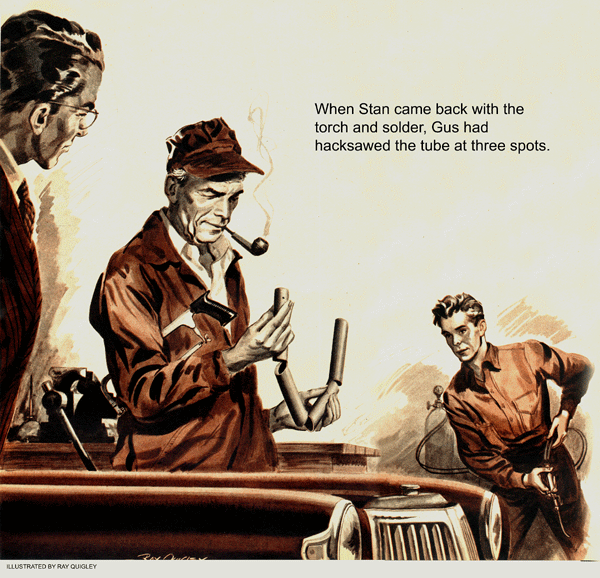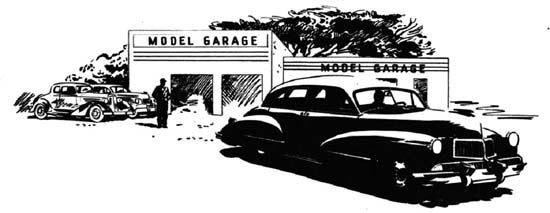May 1949
GUS TURNS THE HEAT OFF
by Martin Bunn
The heat was on in more ways than one.
A used-car dealer started it
when he told his young salesman
to deliver or else, and an old sedan
kept it going until Gus cooled things off.

Stan Hicks bustled into the Model Garage office. Gus Wilson, puffing his pipe, was checking over a stack of accounts with his partner, Joe Clark.
"Boss," Stan broke in, "you know --"
"I'm busy," Gus said without looking up.
"But Boss," Stan persisted, "you know Lem Spardom?"
"No, and I'm still busy," Gus said shortly.
"Aw, have a heart," Stan begged. "Lem's in trouble. He's really up against it now."
"You'll be up against it yourself if you don't stop bothering me," Gus said sternly.
He winked at Joe Clark.
"But Boss . . ." Stan pleaded.
"Okay, okay," Gus grinned, pushing a stack of papers aside. "What's the trouble?"
"It's like this," Stan began. "Lem was in my class in high school. Now he's a salesman for Snedicker -- that used-car dealer down the highway. Lem did all right for a while but he ain't been doing so good lately. Snedicker told him he'd cut off his drawing account if he didn't sell a car this week."
"That's tough," Gus said.
"That ain't all," Stan went on. "This is Saturday afternoon and it's still no sale for Lem. And he's got a wife and kid to take care of, too."
"That's also very tough," Gus said, "but we're running a garage, not a personal-problem clinic for used-car salesmen."
"Aw, Boss . . . "
"Seriously, Stan, what can I do about it?" Gus asked, dropping his hardboiled pretense.
"It's this way," Stan sighed. "Lem's got a car he can sell this afternoon if one thing is repaired. The temperature gauge keeps climbing over into the red. This man told Lem he'd buy the car if it was fixed by four o'clock and you said it was fixed."
"It's after three now," Gus said.
"I know it, "Stan said, "and selling this car is Lem's last chance to hang on to his meal ticket. Otherwise, this customer'll go to another dealer."
"All right," Gus agreed. "Where's this car with the climbing temperature gauge?"
"In the shop," Stan said," and I don't know why it should be climbing so high. The water in the system's not very hot."
"I'll be with you later, Joe," Gus told his partner.
Stan led the way to the shop where Lem Spardom, a studious-looking young man, stood beside a 1941 sedan. He seemed worried, Gus shook hands with him and glanced at the instrument panel. The temperature gauge showed over 200 degrees. Gus stepped around and looked at the engine. He noted that the fan belt and radiator hoses were new.
"See you been having some work done," Gus said.
"Quite a bit," Lem answered. "When our mechanics went over this car they found someone had removed the thermostat. After they put in a new one, the gauge indicated overheating."
"They use the right one for this model?" Gus asked as Stan let the radiator drain.
"They tried two or three different ones, checked and rechecked them but couldn't get anywhere. Before they got through, they put on a new water pump, installed those hoses, reverse-flushed the radiator, and put in cooling-system solvent."
"And it still overheated?" Gus asked.
"The radiator never boils," Lem went on, "but every time you look at the gauge you think it's about to. One of the mechanics wanted to take the thermostat out and just not say anything about it, I couldn't see that. It looked like a dirty trick."
Gus Finds the Hot Spot
"It would have been a dirty trick," Gus agreed. "Yanking the thermostat looks like an easy cure for overheating. Actually, it just covers up the cause of it for a while."
"Well," Lem said, "I don't know about thermostats, but I figured that if the manufacturer put one in, it ought to stay there."
"That's right," Gus said. "Pull one out and you pay for it sooner or later in increased engine wear and higher gas and oil bills. A thermostat temporarily blocks water circulation to let the engine build up to normal running temperature fast. Gasoline vaporizes and oil circulates much better in a warm engine. After she's warmed up, the thermostat lets the water circulate."
"Maybe the temperature gauge is out of whack," Stan suggested.
"Could be," Gus agreed.
"Or the heat-indicator unit on the engine," Stan added.
"Could be that, too," Gus said. "We'll check those two points first. Get me a pan of water, Stan."
Gus removed the heat indicator unit and examined it closely. Then he put the pan of water on a gas ring. When it boiled, he dropped the unit -- still connected to the gauge -- into it. The gauge promptly registered boiling.
"Right on, the nose," Gus commented. "The unit and gauge seem to be okay."
"Now we're right back where we started from," Lem shrugged.
"Oh, it's not that bad," Gus said. "I think I know what the trouble is -- maybe. Get busy and take off the water pump, Stan."
Gus stepped to his workbench, selected a welding rod, and shaped one end into a small hook. Stan removed the pump, revealing a hole into the block where the pump had been. Gus poked the hooked end of the rod into the hole and yanked. Nothing happened. He pulled again, but still nothing happened.
"I get it," Stan said suddenly. "I ought to have thought of it before. Wait a minute," Stan hopped to the bench and came back with a hammer, a small chisel, and a hacksaw.
Gus grinned. He took the chisel and hammer and spent a minute tapping gently around the circumference of the hole. Then he again pushed the hooked rod into the hole. This time he slowly withdrew a few inches of badly rusted oval tubing.
"What's that?" Lem asked.
"The water-distributing tube," Gus said.
"It runs lengthwise through the block inside the cooling jacket. It carries the incoming cooler water from the radiator directly to the valves and valve seats. Keeps them from burning and lengthens their life."
"I didn't even know there was such a thing," Lem said.
"Most car owners don't either," Gus told him, "and some mechanics have a bad habit of forgetting. Every L-head engine built since 1935 that has a water pump in front -- except V-8's -- has one. Before water goes to any other part of the engine, that tube carries it right to the valves."
Gus pulled out a few more inches of the tube and cut the bottom almost through with the hacksaw. Then he bent the section upwards. He continued to pull out the tube, cutting and bending as he went along, until he had removed its entire length. Much of the tube's bottom and sides had been eaten away by rust.
"There's the cause of your trouble," Gus said. He held the tube up. "This should have been replaced a couple of years ago, anyway."
"I don't get it," Lem said. He stared at the corroded tube Gus held. "You mean that rusted tube makes the temperature gauge run up high?"
"That's right," Gus said. "It's so rusted that it couldn't carry water where it should. So you had a localized hot spot where the heat-indicator unit is located on the engine. A new tube will fix it."
The Heat's Off
"Well, that's fine," Lem said, still a little doubtfully, "but I've got to deliver this car in a little over half an hour or I can drive it right back to Snedicker."
"Gee, Lem," Stan said, "can't you get this guy to wait? We'll have to pull the radiator to get the new tube in. That'll take too long."
"If that's the case, I'm sunk," Lem said.
"This man said to bring the car and no overheating by four o'clock, and he meant it."
"That's too bad," Stan sympathized, "but we'll have to pull the radiator. The new tube's too long to get between it said the block. Then we got to put it back."
"Maybe we can beat the deadline," Gus grinned. "Get a new tube from the stock-room, Stan, and make it fast."
Stan made it fast, but when he returned with the tube he found Gus Methodically filling his pipe while Lem hopped around impatiently, Stan wondered why Gus wasn't working on the grille.
"Want me to take off the grille?" Stan asked.
"Never mind the grille," Gus answered.
"It can stay right there. We're going to shortcut this job. Let's have that tube. And get me a torch and some solder."
Gus is one of those expert mechanics who talk slowly never seem to be in a hurry, but work fast. By the time Stan came back with the torch and solder, Gus had hacksawed the new tube three-quarters of the way through at three points. He bent the sections around and pushed the first one into the hole in the block almost as far as the cut. Then he bent down the next section and soldered the cut.
He pushed that section in and soldered the next cut. Working that way he had the new tube installed in less than 10 minutes.
"There you are," Gus said, straightening up from his work. "Almost set to go and we didn't have touch the grille."
"That's swell," Lem grinned, keeping an eye on the clock.
"Put the water pump back on and fill up the radiator," Gus told Stan.
Stan jumped to his work. "If you didn't do that cutting and soldering, what a job that could be on some models -- those that have the grille and fenders as one unit."
"I don't know how to thank you," Lem said. He stuck out his hand. "You sure saved my skin."
"Forget it," Gus answered.
"I'll drive by later and take care of the bill," Lem said, climbing into the car.
"You can tell your customer that the overheating is cured."
Stan filled the radiator and Lem drove out.
"Gee, Boss," Stan told him, "you sure deliver when the heat's on."
"Hey, Gus!" came a sharp yell from the office. "Will you for gosh-sakes come back and finish these accounts with me?"
Gus grinned at Stan. "The heat's still on. What I better do is deliver now, before Joe starts steaming."
END
L. Osbone 2019L. Osbone 2019
